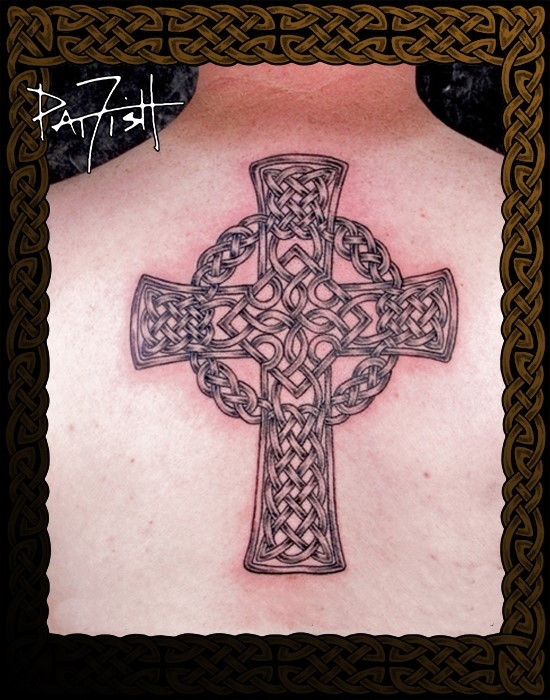link to journal online HERE
When I decided to become a tattoo artist, I didn’t have a single tattoo. In fact, I only knew one person who did. This was obviously in the prehistoric past! My one embellished pal quite sensibly told me that I would lack credibility if I remained blank, and told me to start by getting a tattoo from the very best artist I could. So I contacted Cliff Raven, who did a koi on my shoulder. The experience was everything I had hoped for. He seemed like exactly the combination of craftsman and artist that I would like to be. Raven and I hit it off well, and when I showed him my art portfolio he agreed to teach me how to tattoo.
Right from the beginning I wanted to specialize in Celtic designs. To me they represent a connection with an ethnic and cultural past for which I feel a great fondness. The complexity of the interlacing is both a technical challenge and an opportunity for my dyslexic brain to feel “otherwise-abled” while enjoying the interplay of positive and negative space.
My fascination with the art has led me to make many pilgrimages to the Celtic nations, and I instantly felt at home in Ireland and Scotland. Of particular interest to me are the graveyards, with their magnificent high crosses embellished with intricate interlaced knotwork. I was also lucky enough to study in two summer sessions at Trinity College, Dublin, learning about the monastic tradition and illuminated manuscripts.
The more time I spend with the Celtic designs, the closer I feel to my ancestors who worked as scribes creating holy books and sacred stones. I am descended from the Picts, the “pictorial” ancient inhabitants of Scotland. Their tradition of tattooing their bodies caused them to be uniquely visible, as noted in many ancient histories. When they fought as mercenary soldiers, they stood out on the battlefield!
Many histories of tattooing will say that it was first introduced to Europe when the “tatau” embellished sailors returned from exploring the South Seas. Not so! The Picts are my bloodline, and in my work I bring the style alive for modern tattoo collectors.
Much of my time is spent designing custom Celtic pieces for clients who typically come from quite a distance. I am flattered! I use a wide array of modern technological tools to adapt traditional patterns from source material such as 7th century Irish Celtic illuminated manuscripts and 3rd century Scottish Pictish carved standing stones. I can digitally take a knot and bend or morph it to wrap a body part, using iMacs and Photoshop, and then, once it is stenciled on the body, I typically spend quite a bit of time fine tuning the pattern to find the right balance between geometric precision and the likelihood that the client’s body has asymmetricalities that we don’t want to emphasize.
It is definitely a niche that I am happy to be working in. In my first years learning how to tattoo I did my share of tribal suns on butt-cracks, paying dues and getting the technical skill to be able to accomplish the more fulfilling work I am now asked to create.
As with any artistic career, as your level of proficiency with the medium increases, so does your level of satisfaction. Right now I am attracting clients whose concepts are elaborate enough, extensive in scope and size, to let me explore new techniques for shading and texture. This allows me to incorporate inspiring methods I see online in photographs, developed by artists working in quite different styles, and find ways to add those clever ideas to my own bag of tricks.
Over the past thirty-eight years I have watched with great interest the changes in the tattoo industry. For my own career the single most important development has been the internet. Being able to market my studio and designs online has led to clientele from all over the world finding me. Amazing! My main website, www.luckyfish.com, was one of the first tattoo sites online, and I have been tweaking and improving it ever since.
In 2001 I started selling my flash online to enable enthusiasts of specifically Celtic designs to have access to an expanding selection of unique custom patterns to take to their local artist for installation. I always show a photo of the finished tattoo in my online store, www.luckyfishart.com, so the consumer can clearly visualize the art as a tattoo. Other flash sale sites have appeared online in the years since, but they show only drawings and I know that people shopping for tattoo patterns appreciate seeing the finished result. I figure if they could visualize line art into a tattoo the way I can, they’d want my job!
A lot of studios refer their clients to my image site, which is a win-win for all of us. The client takes all the time they need to pick a pattern at home online, then returns to their artist with a packet of images, a photo, line art, shaded and colored examples, all downloaded instantly upon purchase. In the years I have been running the store I’ve added over 2000 images, one by one, as I design and tattoo them. I’m proud that I’m helping the tattoo community with a resource that assists them to install quality Celtic tattoos, with more variety than can be achieved from using the same old books of clip art.
I imagine my Pictish ancestors are smiling over their designs coming to life again in the skins of modern tattoo enthusiasts. I am proud to give people with Celtic bloodlines a way to show their connection with their heritage, a permanent externalization of their internal aesthetics.






